
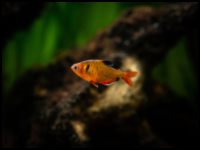
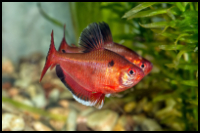
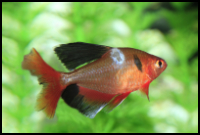
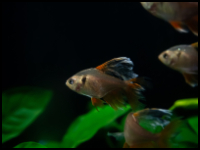
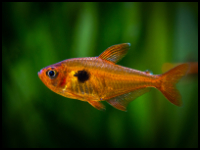
Quick Care Details (Table)
| Livestock Characteristics | Value |
|---|---|
| Care Level | Easy |
| Temperament | Semi-Aggressive |
| Diet | Omnivore |
| Maximum Size | 2 Inches |
| Minimum Tank Size | 10 Gallons |
| Plant Safe | Yes |
| Temperature Range | 72-82F |
| PH Range | 6.0-7.5 |
| KH Range | 4-8 |
Species Specific Categories
Helpful Video
Care Details
Aquascape: When you're setting up your Serpae Tetra tank, think about creating a lovely, natural vibe. Add some real or fake plants, driftwood, and rocks to give them a slice of their native Amazonian habitat. These little guys love having cozy hiding spots and open spaces for playful swimming. You can also toss in some floating plants for a bit of shade and to make the lighting look more natural.
Substrate: For the bottom of the tank, go with soft, fine sand or smooth gravel. These fish do not interact with the substrate, so they can have any substrate or even none at all.
Disease Prevention: To keep your Serpae Tetras in top form, keep their water clean with regular water changes. Be a bit of a detective and keep tabs on the water quality. If you're adding new fish to the gang, quarantine them for a while just to be safe. And don't overcrowd the tank – it can stress them out. Feed them a good, balanced diet to keep their immune systems robust.
Filtration: Think of your filter as the bouncer at a club - it's there to keep the riff-raff out and maintain order. Get one that's appropriately sized for your tank. A well-functioning filter will help you keep the water quality consistent and your fish happy.
Lighting: Your Serpae Tetras aren't too picky about lighting. Just aim for a regular day-night cycle with moderately bright lights. Consistency is the name of the game here to keep their daily routine running smoothly.
Water Flow: These fish come from slow waters, but they can handle different water flow rates. You can use a filter output or an airstone to create gentle water movement. It helps to distribute heat and oxygen evenly throughout the tank.
Hardiness: Serpae Tetras are like the adaptable backpackers of the fish world. They can handle different water conditions, but they'll be much happier in a stable, comfortable home.
Acclimation: When you introduce new fish to your tank, be a good host. Float the bag they came in to match the temperature and gradually mix in some tank water. It helps the newbies adjust to their new digs.
Expected Lifespan: With the right care, your Serpae Tetras can be part of your life for about 3 to 5 years. Some lucky ones have even clocked more time in well-kept tanks.
Special Requirements: These little guys are chill, but they love company. Keep them in groups of at least 6 to make them feel like they're at a non-stop party. Also, feed them a mix of goodies and keep an eye on their health. Happy and healthy Serpae Tetras will bring life to your tank!
Temperament and Behavior
Behavior: Serpae Tetras are real live wires! They're the energetic bunch in your tank, constantly darting around, checking out every nook and cranny. These little guys bring a ton of action and playfulness to your aquarium.
Breeding: Breeding these fellas can be a bit of a project. You'll need a separate breeding tank with soft water and a slightly acidic vibe. Toss in some fine-leaved plants for egg-laying, but remember to relocate the grown-ups once they've done the deed to keep them from snacking on their own offspring.
Aggression: They do have a reputation for being a bit nippy, especially when they're in smaller groups. In those cases, they might pester other tank mates by nipping at their fins. But, if you've got a bigger school, they tend to keep their nipping within the group, which is less of a bother.
Tankmates Compatibility: Usually, these fish are pretty easygoing, but in smaller numbers, they can get a tad feisty. It's best to keep them with other fish that can handle their semi-aggressive side. Think about other tetra species, danios, rasboras, or some chilled-out bottom-dwellers like Corydoras catfish. These fish should not be kept with slow-moving fish with long fins. For example keeping them with a Betta is a bad idea.
Activity Level: They're like the party animals of the aquarium. Always on the move, they add a burst of life to your underwater world. You won't find them hiding in the background; they're right in the middle, making the tank a lively place.
Schooling or Shoaling Behavior: These little guys are all about the gang. They feel comfy and safe when they're part of a crew, preferably six or more. In a school, they're less likely to be nippy, and you'll see more of their natural behaviors as they swim together.
Plant Compatibility: Serpae Tetras can coexist with live plants, but they might nibble on the softer ones. To protect your leafy friends, go for tougher plant species or toss in some floating plants. They usually don't mess with those. Plus, plants offer them hideouts and territory markers.
Diet and Nutrition
Dry Foods: Think of dry fish foods like the everyday staples. These are your typical fish flakes or pellets you can easily find in pet stores. Go for high-quality tropical fish flakes or pellets to make sure your Serpae Tetras get all the essential nutrients.
Frozen Foods: Frozen fish foods are like a fancy dinner for your fish. Things like bloodworms, brine shrimp, and daphnia are great choices. Before serving, just thaw them out, and your Serpae Tetras will have a feast.
Live Foods: Live foods are like a treat day. It's like taking your fish out to their favorite restaurant. Options like live brine shrimp or daphnia are packed with nutrition and can be a special delight for your fish once in a while.
Vegetables: Your Serpae Tetras aren't veggie lovers, but they might nibble on some blanched veggies every now and then. Offer them things like blanched spinach, zucchini, or cucumber slices. It's like giving them a little side dish.
Algae: While they won't chow down on algae like some fish, having a bit of algae in your tank can be like leaving snacks around. They might graze on it a bit. If you have live plants, they might also find tiny critters on them to munch on.
Feeding Schedule: Imagine you're feeding your fish like you're having meals. Two times a day is good, but don't go overboard. Give them an amount of food they can finish in about 2-3 minutes. It's like serving them a plate of food and letting them enjoy it, but not piling on more than they can eat.
Supplemental Foods: Besides their regular dry food, you can treat your Serpae Tetras with frozen or live foods once in a while. It's like giving them dessert – a special and tasty addition to their diet. Once or twice a week is usually enough.
Tank Parameters
Tank Size: Think of a tank for Serpae Tetras like finding the right home. A 10-gallon (38 liters) tank is the minimum, but a bit larger is even better. It provides more space for them to swim and feel comfortable.
Tank Length and Measurements: When you're picking out a tank, consider one that's at least 20 inches (50 cm) in length. This gives them ample room to swim around, which they love.
Water Temperature: Imagine your tank as a cozy room with the temperature set to 72-78°F (22-26°C). This range suits Serpae Tetras perfectly, making them feel right at home.
pH (Acidity/Alkalinity): Think of the water in your tank as having its own personality. Serpae Tetras prefer water that's slightly acidic to neutral. Aim for a pH level around 6.5 to 7.5 to keep them comfortable.
KH (Carbonate Hardness): This is like the water's ability to buffer against pH changes. Serpae Tetras do well in moderately soft to slightly hard water. A KH of 3-10 is a good range to aim for.
GH (General Hardness): The general hardness of the water is like its mineral content. Serpae Tetras are adaptable and can thrive in water with a GH level of 5-20. This range gives them some flexibility.
Hardiness: Serpae Tetras are fairly tough cookies. They can adapt to different water conditions, which makes them a good choice for both beginners and experienced aquarists. Just try to keep things stable for their sake.
Nitrate (NO3) Levels: Think of nitrates as the leftovers from your fish's meals. You want to keep these in check. Keep nitrate levels below 40 ppm (parts per million) through regular water changes. It's like ensuring the air in your home is clean and fresh for your fish.
History, Popularity, History and Species Variety Details
The History, Popularity and Natural Habitat
History: Serpae Tetras have been around the aquarium scene for quite a while. They made their debut in the early 1900s and quickly won over the hearts of fish enthusiasts. Their vibrant red colors and active personality have made them a favorite choice for many fish keepers.
Popularity: These little fish are like the celebrities of the fish tank world. Their eye-catching red hues and lively behavior have made them a hit with hobbyists. People just love how active and vibrant they are in the aquarium. Their striking looks and relatively easy care have solidified their place in the hearts of fish keepers.
Natural Habitat: Picture the Amazon River and its calm, slow-moving side streams. That's where Serpae Tetras call home in the wild. They're perfectly suited for the warm, slightly acidic waters of South America. You'll find them hanging out in areas with lots of plants, using the vegetation as both a hideout and a way to blend in with their surroundings. In their natural habitat, they usually roam around in schools, which provides safety in numbers.
Knowing about the history, popularity, and natural habitat of Serpae Tetras helps us appreciate these fascinating fish and how they've become such cherished members of the aquarium community.
Back to topFish That Are Similar To The Serpae Tetra
- Black Skirt Tetra (Gymnocorymbus ternetzi): Black Skirt Tetras are similar in shape to Serpae Tetras but have a more subdued coloration, usually featuring black or dark gray bodies with a black band near their tail. They are a peaceful and popular choice for community aquariums.
- Bloodfin Tetra (Aphyocharax anisitsi): Bloodfin Tetras are another close relative. They have silvery bodies with a distinctive red fin on their anal fin. They are generally peaceful and can coexist with other small, non-aggressive fish.
- Red-Eyed Tetra (Moenkhausia sanctaefilomenae): Red-Eyed Tetras have a similar body shape to Serpae Tetras but with a more orange or reddish coloration and, as the name suggests, striking red eyes. They are known for their peaceful nature and can be kept in a community aquarium.
- Serpae Tetra Color Variations: There are also various selectively bred color variations of the Serpae Tetra. These include long-finned varieties and different color morphs, such as albino Serpae Tetras, which have a lack of pigmentation and appear pale or white.
- Black Phantom Tetra: a small, peaceful freshwater aquarium fish known for its almost black body with a distinctive reddish or orange patch near the tail base.
Male gender vs Female Gender (Sexual Dimorphism)
Males: Male Serpae Tetras are like the peacocks of the tank. They strut their stuff with flashy, vibrant colors, especially in their top and bottom fins. It's like they're dressing up for a special occasion, wearing attention-grabbing outfits.
Females: Female Serpae Tetras, on the other hand, are a bit more low-key. They have paler colors, especially in their fins, which are often more see-through or lighter. It's as if they prefer a more subtle and understated fashion.
These differences in coloration become most apparent when the males are trying to woo the females during the breeding season. Just like humans sometimes put on their best attire to impress someone special, male Serpae Tetras flaunt their colors to catch the eye of the ladies!
- Separate Breeding Tank: Picture it as setting up a cozy bedroom for a special night. Create a separate breeding tank with soft lighting and some fine-leaved plants. This provides a comfortable space for your fish to lay their eggs and feel the love.
- Condition the Breeders: Think of it as getting ready for a big date. Feed your breeding pair high-quality foods like live or frozen brine shrimp and bloodworms to ensure they're in their best shape.
- Select a Compatible Pair: It's like setting up your best friend with a good match. Make sure you have a pair that gets along well and is in top health.
- Trigger Breeding: Imagine playing some romantic music or lighting candles. You can stimulate breeding by doing a water change with slightly cooler water. This mimics the rainy season and can get your fish in the mood for love.
- Egg-Laying and Nest: When it's time, the female will scatter her eggs among the fine-leaved plants, while the male fertilizes them. It's like creating a safe, intimate space with soft lighting and cozy spots.
- Separate the Adults: After the eggs are laid, it's like giving the new parents some alone time. Remove the adult Serpae Tetras from the breeding tank to ensure the little ones have some privacy.
- Care for the Fry: When the eggs hatch, the tiny fry will initially feed on their yolk sacs. As they grow, introduce infusoria and later freshly hatched brine shrimp to their menu, much like giving them some baby food.
- Maintain Water Quality: Keep the breeding tank clean and stable, just like keeping your home tidy for your family. Regular small water changes will help ensure the best conditions for the growing fry.
Breeding Serpae Tetras can be a bit like planning a special romantic evening – it takes some effort, but the results can be very rewarding.
Back to top
Frequently Asked Questions
What are Serpae Tetras, and where are they from?
Serpae Tetras are vibrant, small fish native to the Amazon River basin in South America.
How big do Serpae Tetras grow?
They typically reach around 1.5 to 2 inches (4-5 cm) in length.
Do they require a large tank?
A 10-gallon tank or larger is ideal for a small school of Serpae Tetras.
Are Serpae Tetras peaceful or aggressive?
They're generally peaceful but can be a little aggressive with slower fish. You should avoid fish with longfins since these fish are well-known fin nippers.
What should I feed my Serpae Tetras?
Offer them a varied diet of tropical fish flakes, frozen foods like bloodworms, and occasional live foods like brine shrimp.
Can I breed Serpae Tetras in my tank?
Breeding them can be a rewarding project. Create a separate breeding tank with soft lighting and provide them with a conducive environment for egg-laying.
How many Serpae Tetras should I keep in a school?
To see their natural behaviors and reduce nippiness, maintain a school of at least six individuals.
How long do Serpae Tetras live in captivity?
With proper care, they can live up to 5 years or even longer in your aquarium.

